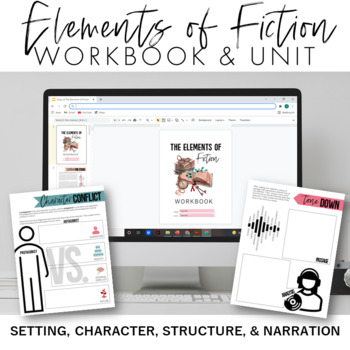Elements of Fiction Unit & Workbook Setting, Character, Structure, & Narration
- Zip
Description
Engage your students in the study of the elements of fiction while meeting all the AP English Literature and Composition Essential Knowledge Skills. This workbook is a complete unit to teach students how to analyze the elements of short stories, narratives, and other works of fiction. Breaking down the skills by character, setting, structure, narration, and figurative language, students will master the skills necessary for analyzing literature.
This unit aligns to the AP English Literature and Composition Conceptual Framework for Short Fiction, and it perfect for grades 9 through 12 as it meets Common Core standards for Reading: Literature for those grades. Best of all, this unit can be used with any short story text.
A complete teaching guide with suggested texts representing diverse perspectives is included, but these activities can be used with any texts in your curriculum. The main content and directions are editable, so you can modify parts of the unit to meet the needs of your students. It also comes with both print and digital options.
Activities included:
- Setting the Stage: A visual activity for connecting setting to mood
- Setting the Mood: An activity for connecting imagery to mood
- Setting the Details: A passage analysis for connecting details of a setting to values of the time period
- Setting Up Contrast: A passage analysis for analyzing contrast in setting
- From Setting to Symbol: A graphic organizer for analyzing symbolism
- Setting Pen to Paper: A writing practice for establishing and supporting claims about setting
- In Character: An activity for characterization of a character based on the characters speech, action, and inaction
- Out of Character: An activity for characterization of a character based on other characters interactions with the character
- Character Conflict: An activity to explore protagonists and antagonists
- Character Cards: Task cards to analyze character value systems, character epiphanies, and personification
- Character Witness: A writing practice for establishing and supporting claims about characters
- Plot It Out: A graphic organizer for identifying the dramatic situation in the exposition
- Plot Pacing: A passage analysis to explore narrative pacing
- Plot Pieces: An activity to analyze the effect of tempo, narrative structure, frequency of events, arrangement, syntax, and shifts in a work
- Roller Coaster Writing: A poster-making activity to visually connect the plot of a work of literature to the dramatic situation for the characters
- Get Perspective Task Cards: Task cards to explore first person, second person, third person, and stream of consciousness point of view
- Set the Tone: A passage analysis for analyzing tone in a dramatic work
- Tone Down: An activity for analyzing tone in a work of literature
- Put It In Perspective: An activity for assessing a narrator's reliability
Check out the video preview for more details!
What's included:
- Elements of Fiction Workbook PowerPoint with editable directions and content
- Elements of Fiction Workbook Google Slides with editable directions and content
- Teacher directions for each activity with an outline of the AP Essential Knowledge skills that connect to that activity
- Text suggestions for short works of fiction that exemplify the element being studied
⚠️ Because this unit was designed to be completed with any work of fiction, an answer key cannot be included.


